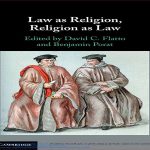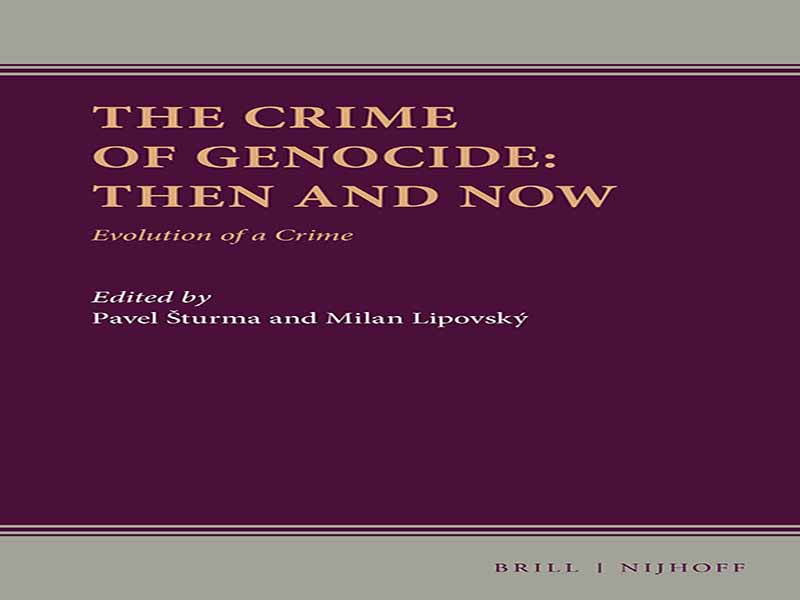- عنوان کتاب: The Crime of Genocide: Then and Now
- نویسنده: Pavel-Šturma,-Milan-Lipovský
- حوزه: نسل کشی
- سال انتشار: 2022
- تعداد صفحه: 345
- زبان اصلی: انگلیسی
- نوع فایل: pdf
- حجم فایل: 2.60 مگابایت
کنوانسیون پیشگیری و مجازات جنایت نسلکشی که در 9 دسامبر 1948 به تصویب رسید، در 12 ژانویه 1951 لازمالاجرا شد. به منظور نشان دادن اهمیت رویداد اخیر برای تحول حقوق بینالملل، پاول اشتورما و میلان لیپوفسکی جلسهای را تشکیل دادند. کنفرانس بین المللی تحت نظارت مرکز شکوفای حقوق بشر دانشگاه چارلز پراگ. در سپتامبر 2020، زمانی که کنفرانس برگزار شد، این بیماری همه گیر در پراگ نیز ثابت ماند. این دو سازماندهنده و تیم قدرتمندشان همراه با دعوتکنندگان خود، که عمدتاً از اروپای مرکزی آمدهاند، نشان دادند که، اگرچه هیچ چیز نمیتواند به طور کامل جایگزین تبادل علمی چهره به چهره شود، یک مکالمه آکادمیک معنادار و حتی پر جنب و جوش واقعاً به شکل دیجیتال در سایت امکانپذیر است. اساس یک ساختار خوب با توجه به موفقیت کنفرانس، دعوت کنندگان آن باید به دلیل ویرایش اکثر مقالات – با بازنگری های معین و با افزودن ارجاع به پاورقی ها – در قالب این مجلد مورد تقدیر قرار گیرند. در هسته خود، «جنایت نسلکشی در آن زمان و اکنون: تکامل یک جنایت»، مطالعات حقوقی بینالمللی را با ماهیت دکترینال، هم از منظر حقوق کیفری بینالمللی و هم از منظر قانون مسئولیت دولت در قبال اعمال غیرقانونی بینالمللی، جمعآوری میکند. این کتاب طیف گسترده ای از وقایع را در بر می گیرد که از زمان قبل از لازم الاجرا شدن کنوانسیون نسل کشی تا سال های اخیر (فقط به چارچوب زمانی تحت پوشش کاتارینا شیمیگوا نگاه کنید) و شامل بینش های نزدیک در مقدمات و تجزیه و تحلیل دقیق درباره است. جدیدترین تحولات در عمل قضایی و دانش حقوقی. در حالی که هیچ ادعایی مبنی بر تغییر اساسی در تعریف نسل کشی در نتیجه عملکرد دولت ها پس از لازم الاجرا شدن کنوانسیون نسل کشی وجود ندارد، هیچ خواننده ای از این کتاب نمی تواند درک کند که رویه دولت ها، رویه قضایی تا چه اندازه است. دادگاههای بینالمللی و داخلی، و کار محققان، بهویژه از دهه 1990، منجر به درک دقیقی از مفهوم حقوقی بینالمللی نسلکشی و همچنین به تشریح دقیقتر حوزههای متعدد مناقشات باقیمانده شده است. این با توجه به طیف گسترده ای از مسائل حقوقی اساسی، مانند نیت نسل کشی (Michala Chadimová)، گروه های محافظت شده (Veronika Bílková، Kateřina Uhlířová)، و رابطه متقابل بین مسئولیت دولت و فردی، با جزئیات قابل توجه و با دقت زیاد نشان داده شده است. پاول اشتورما) و مفهوم تلاش برای نسلکشی که تاکنون بسیار کمتر مورد بررسی قرار گرفته بود (Nikola Kurková Klímová) و همچنین با توجه به مرزهای صلاحیت «سرزمینی» دادگاه کیفری بینالمللی- بر جنایت نسلکشی (کریستینا اوربانووا) و اعمال صلاحیت جهانی بر آن جرم توسط دادگاه های داخلی (Milan Lipovský). در حالی که اکثر فصول آن تحلیل خود را بر قانون موجود علیه نسل کشی متمرکز می کنند، مجموعه به همین جا ختم نمی شود. Harald C. Scheu مجموعه قانون اخیر را در چارچوب گسترده تر آن از حقوق بین الملل حقوق بشر و به ویژه حقوق بین الملل در مورد حمایت از اقلیت ها قرار می دهد، و Eliška Mocková مفهوم موجود نسل کشی را به دلیل حذف قتل سیستماتیک مردم مورد انتقاد قرار می دهد. دارای معلولیت پس از یادآوری خاطره دردناک از جنایات گذشته از این نوع. مارکوس پی بیهام تحلیل را حتی فراتر از قانون و سیاست حقوقی حرکت میدهد و بحث حقوقی کنونی را با بحثی که توسط محققان سایر رشتهها تحت عنوان چتر «مطالعات نسلکشی» انجام میشود، مرتبط میکند. آخرین، اما نه کم اهمیت، این جلد شواهد بیشتری برای این واقعیت ارائه میکند که در حالی که حقوق بینالملل علیه نسلکشی در هستهی خود دارای ویژگی جهانی است، دیدگاههای سیاست منطقهای و حتی ملی در مورد آن مجموعه قوانین ممکن است از نظر تأکید متفاوت باشد. تاماس هافمن روشن می کند که چگونه تجربه اش با حاکمیت کمونیستی در گذشته نه چندان دور همچنان بر رویکرد سیاستی تعدادی از کشورهای اروپای مرکزی در قبال قانون علیه نسل کشی (و به طور گسترده تر در مورد قوانین کیفری بین المللی) تأثیر می گذارد، و اوندری سواچک، کاملاً مناسب با توجه به مکان کنفرانس، بینشی از تجربه چکسلواکی و سپس چک در مورد کنوانسیون نسل کشی ارائه می دهد. «جنایت نسلکشی در آن زمان و اکنون: تکامل یک جنایت» کمکهای با کیفیت علمی بالا با تفکر تازهای در مورد پیچیدگیهای سیاست حقوقی و حقوقی بینالمللی نسلکشی هفتاد سال پس از لازمالاجرا شدن کنوانسیون نسلکشی جمعآوری میکند. آخرین اما نه کماهمیت، این مجموعه خوب نشان میدهد که بورسهای تحصیلی حقوقی بینالمللی از اتریش، جمهوری چک، مجارستان، لهستان، و اسلواکی – از جمله تعداد کمی از نمایندگان جوانتر آن – در مورد این موضوع جذاب چقدر باید بگویند. نه چندان دور از زادگاه او، حتی پس از چندین دهه، میراث رافائل لمکین خلاقانه ترین طنین انداز است.
Adopted on 9 December 1948, the Convention on the Prevention and Punishment of the Crime of Genocide entered into force on 12 January 1951. In order to mark the importance of the latter event for the evolution of international law, Pavel Šturma and Milan Lipovský convened an international conference under the auspices of Prague’s Charles University’s flourishing Human Rights Center. In September 2020, when the conference took place, the pandemic kept a firm hold also over Prague. Together with their invitees, mainly coming from Central Europe, the two organizers and their formidable team, demonstrated that, albeit nothing can fully replace face to face scholarly exchange, a meaningful, even vibrant academic conversation is indeed possible in digital form on the basis of a well- conceived structure. Given the conference’s success, its conveners must be commended for having edited most of the papers – with certain revisions and with the addition of references in footnotes – in the form of this volume. At its core, ‘The Crime of Genocide Then and Now: Evolution of a Crime’ collects international legal studies of a doctrinal nature, both from the perspectives of international criminal law and the law of state responsibility for internationally wrongful acts. The book covers a wide variety of events extending from the time predating the Genocide Convention’s entry into force until the most recent years (look solely at the time frame covered by Katarína Šmigová) and it contains both close insights in the travaux préparatoires and detailed analysis of the most recent developments in judicial practice and in legal scholarship. While no claim is made that the definition of genocide has undergone substantial change as a result of the practice of states subsequent to the Genocide Convention’s entry into force, no reader of this book can fail to appreciate to what extent the practice of states, the jurisprudence of international and domestic courts, and the work of scholars, especially since the 1990’s, have led to a refined understanding of the international legal concept of genocide as well as to a sharper delineation of the multiple areas of remaining controversies. This is demonstrated in significant detail and great precision with respect to a wide range of substantial legal issues, such as genocidal intent (Michala Chadimová), protected groups (Veronika Bílková, Kateřina Uhlířová), and the interrelation between state and individual responsibility (Pavel Šturma) and the hitherto much less explored concept of attempted genocide (Nikola Kurková Klímová) as well as with a view to the boundaries of the International Criminal Court’s ‘territorial’ jurisdiction- limb over the crime of genocide (Kristýna Urbanová) and to the exercise of universal jurisdiction over that crime by domestic courts (Milan Lipovský). While the majority of its chapters focus their analysis on the existing law against genocide, the collection does not stop there. Harald C. Scheu situates the latter body of law in its broader context of international human rights law and, more particular, international law on the protection of minorities, and Eliška Mocková criticizes the existing concept of genocide for excluding the systematic murder of people with disabilities after recalling the painful memory of past atrocities of that kind. Markus P. Beham moves the analysis even beyond law and legal policy and connects the present legal debate with that conducted by scholars from other disciplines under the umbrella term of ‘Genocide Studies’. Last, but not least, the volume provides further evidence for the fact that, while the international law against genocide is of a universal character at its core, regional and even national policy perspectives on that body of law may differ in emphasis. Tamás Hoffmann sheds light on how its experience with the communist rule in the not so distant past continues to influence the policy approach of a number of Central European countries to the law against genocide (and to international criminal law more broadly), and Ondřej Svaček, quite appropriately in regard to the location of the conference, presents an insight into the Czechoslovak and then Czech experience with the Genocide Convention. ‘The Crime of Genocide Then and Now: Evolution of a Crime’ assembles contributions of high scholarly quality with a lot of fresh thinking on the international legal and legal policy complexities of genocide seventy years after the Genocide Convention’s entry into force. Last but not least, the fine collection shows how much international legal scholarship from Austria, the Czech Republic, Hungary, Poland, and Slovakia – including quite a few of its younger representatives – have to say on this intriguing subject matter. Not too far from his birthplace, even after decades Raphael Lemkin’s legacy resonates most creatively.
این کتاب را میتوانید از لینک زیر بصورت رایگان دانلود کنید:
Download: The Crime of Genocide: Then and Now

































نظرات کاربران